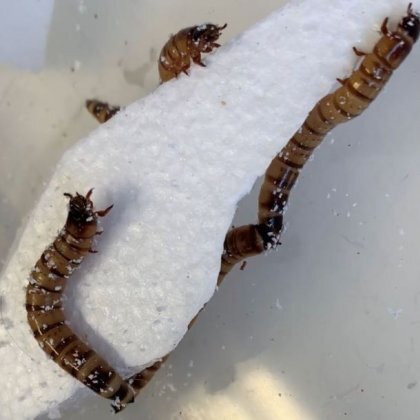The magnitude of our plastic waste problem has scientists searching far and wide for answers, and for a team at Australia’s University of Queensland (UQ) this search has led them to hungry little critters known as “superworms.” These tiny creatures have now been shown to have a healthy appetite for plastic waste, which the researchers were able to trace to specific enzymes in their gut bacteria that convert it into energy, even leading the worms to gain weight as a result.
The Zophobas morio species at the center of this study earn themselves the “superworm” moniker due to their big and brawny nature, and research has started to hint at their potential to degrade plastic waste. The UQ team delved into these possibilities by studying the gut microbiome of Zophobas morio placed on different diets over a three-week period, with some fed bran, another group fed polystyrene only, and another group made to starve.
This brought about considerable differences in the gut microbial communities, with those starving and fed polystyrene showing less microbial diversity and a higher presence of opportunistic pathogens. Though the polystyrene group experienced these negative health effects, they did still gain weight as a result of their plastic diet.
“We found the superworms fed a diet of just polystyrene not only survived, but even had marginal weight gains,” said Dr Chris Rinke, who led the research. “This suggests the worms can derive energy from the polystyrene, most likely with the help of their gut microbes.”

University of Queensland
Using a technique called metagenomics, the scientists were then able to identify a set of bacterial enzymes responsible for the degradation of polystyrene, supporting the hypotheses raised in earlier research. This forms the first insights into the metabolic pathways that enable superworms to degrade polystyrene, a process the scientists say even churns out valuable by-products as a result.
“Superworms are like mini recycling plants, shredding the polystyrene with their mouths and then feeding it to the bacteria in their gut,” Dr Rinke said. “The breakdown products from this reaction can then be used by other microbes to create high-value compounds such as bioplastics.”
The findings add to a growing list of discoveries demonstrating how enzymes can degrade plastic materials, and could therefore play an important role in our efforts to manage waste. These include fast-acting enzymes that break down plastics in as little as 24 hours, enzymes that reduce plastics to a single molecule, enzymes that can be embedded in plastic material to help them decompose, and engineered “super-enzymes” that gobble up waste at high speed.
The UQ team holds similar ambitions, hoping to engineer versions of these enzymes that can work with mechanical systems at recycling plants to biodegrade plastics once the shredding is done. It is now shifting its focus toward that possibility, beginning with efforts to grow the superworm gut bacteria in the lab and testing its ability to degrade polystyrene.
“We can then look into how we can upscale this process to a level required for an entire recycling plant,” said study co-author Jiarui Sun.
The research was published in the journal Microbial Society.
Source: University of Queensland
Source of Article